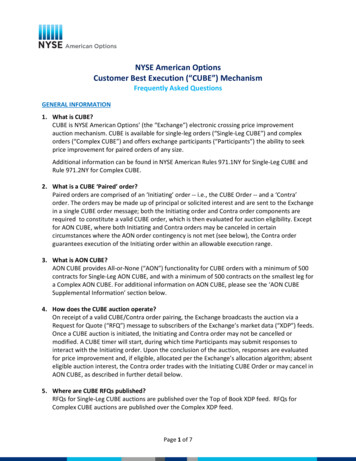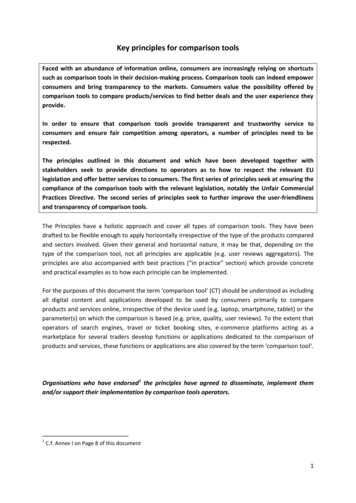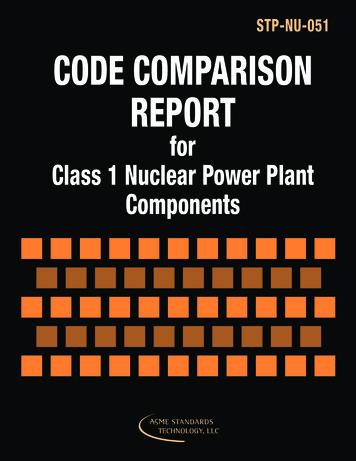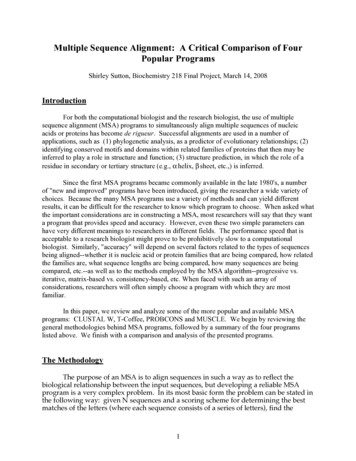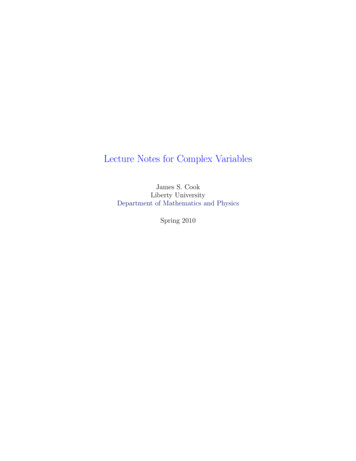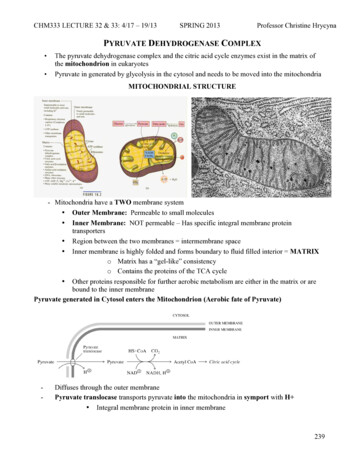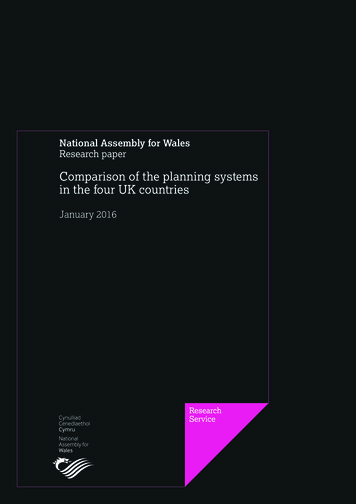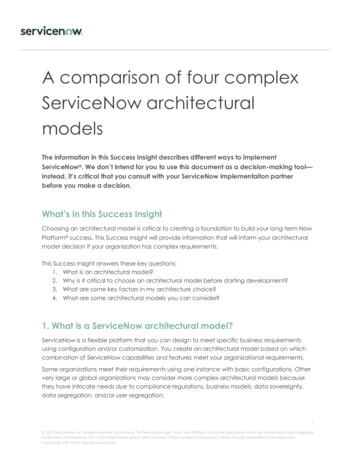
Transcription
A comparison of four complexServiceNow architecturalmodelsThe information in this Success Insight describes different ways to implementServiceNow . We don’t intend for you to use this document as a decision-making tool—instead, it’s critical that you consult with your ServiceNow implementaiton partnerbefore you make a decision.What’s in this Success InsightChoosing an architectural model is critical to creating a foundation to build your long-term NowPlatform success. This Success Insight will provide information that will inform your architecturalmodel decision if your organization has complex requirements.This Success Insight answers these key questions:1. What is an architectural model?2. Why is it critical to choose an architectural model before starting development?3. What are some key factors in my architecture choice?4. What are some architectural models you can consider?1. What is a ServiceNow architectural model?ServiceNow is a flexible platform that you can design to meet specific business requirementsusing configuration and/or customization. You create an architectural model based on whichcombination of ServiceNow capabilities and features meet your organizational requirements.Some organizations meet their requirements using one instance with basic configurations. Othervery large or global organizations may consider more complex architectural models becausethey have intricate needs due to compliance regulations, business models, data sovereignty,data segregation, and/or user segregation.1 2021 ServiceNow, Inc. All rights reserved. ServiceNow, the ServiceNow logo, Now, Now Platform, and other ServiceNow marks are trademarks and/or registeredtrademarks of ServiceNow, Inc. in the United States and/or other countries. Other company and product names may be trademarks of the respectivecompanies with which they are associated.
The most commonly used architectural models used to meet complex requirements are: Deliberate customization – This is a very flexible model that uses baseline capabilities toextend out-of-the-box (OOTB) applications for complex business requirements. Application extension – This model extends baseline capabilities to provide a new,scoped, application based on an OOTB application. This lets you maintain the app’soriginal purpose with development and configuration for each independent user group. Domain separation – This model takes advantage of OOTB functionality on a singleServiceNow instance to enable data and process segregation appropriate for separatebusiness lines and/or customers. A shared database is leveraged across these segments. Multiple instances – This model involves multiple production instances of ServiceNow thatare each purpose-built for a specific set of business needs.2. Why is it critical to choose an architectural model beforestarting development?Your architectural model will be the foundation for your success with ServiceNow. If you startdeveloping with a model that isn’t the right fit for your requirements, the time and rework to alignto a more appropriate model can be costly. To make matters worse, you can’t easily reversedsome architectural models after you’ve started development. For example, if you activatedomain separation but later decide it wasn’t the right choice, the best way to undo it is to startover in a new ServiceNow instance. On the other hand, if if you don’t choose domainseparation initially, it’s very difficult to adopt later.3. What are some key factors in my architecture choice?Your architecture decision should be informed by your application and platform requirements.Consider how these five factors relate to your organization:1. Data – Think about the capabilities you need to segregate users and/or data to meet yourbusiness needs and regulations, such as data sovereignty. Also consider the integrations anddata sharing you need to meet your requirements. These could include transactional dataand master data management sharing with other systems, interactional workflows to enablebusiness process automation, and the volume and frequency of integration processing,which could impact performance.2. Process – Determine your business needs and the processes that must be in place for yourorganization to manage workflows and to adhere to regulatory compliance.2 2021 ServiceNow, Inc. All rights reserved. ServiceNow, the ServiceNow logo, Now, Now Platform, and other ServiceNow marks are trademarks and/or registeredtrademarks of ServiceNow, Inc. in the United States and/or other countries. Other company and product names may be trademarks of the respectivecompanies with which they are associated.
3. Manageability – Evaluate whether you have internal resources with the rights skills andavailability to take on the roles of administrator and developer. Are the internal governanceprocesses you have in place strong? Do you have well-defined processes for scoping andmanaging development on the platform?4. Performance and scalability – Assess how quickly you need to be able to adapt to changesin the organization. Also consider the expectations for system performance.5. Technical sustainability – Weigh the priority of keeping the platform running smoothly and toeasy to upgrade against your need to have specific, customized features that may makeServiceNow more difficult to manage. This would include the complexity of yourimplementation as well as the level of technical debt and risk the organization wants toassume.4. How do different complex models compare?We have identified four common complex implementation models: deliberate customization,domain separation, multiple instances, and application extension. Let’s look at each of thesemodels in more detail.Deliberate customizationDescriptionThis is a very flexible model that uses baseline capabilities to extend out-of-thebox (OOTB) applications for complex business requirements.Common customerprofileAll organization types can use this model but those with a high degree of processflexibility are most likely to select it.Example use cases A customer had a unique process requirement that could not be met withOOTB capabilities.A large technology company switched from scoped apps to deliberatecustomization because it needed the ability to share data across teams.A large bank needed to have six countries use the same process, be able toshare records, and segregate some data. They used access control lists tocreate a customized data model.3 2021 ServiceNow, Inc. All rights reserved. ServiceNow, the ServiceNow logo, Now, Now Platform, and other ServiceNow marks are trademarks and/or registeredtrademarks of ServiceNow, Inc. in the United States and/or other countries. Other company and product names may be trademarks of the respectivecompanies with which they are associated.
Application extensionDescriptionThis is a very flexible model that uses baseline capabilities to extend OOTBapplications for complex business requirements. This model can become overlycomplicated and problematic as complexity increases over time, so onlyconsider it if you have compelling or essential business value that you can’tachieve with OOTB applications.Common customerprofileAll organization types can use this model but those with a high degree of processflexibility are most likely to select it.Example use cases An organization wanted to provide data and process flexibility to sub-unitswithin the organization and/or delegate development to those sub-units. A restaurant group required process and data separation between brandsbut wanted to retain the ability aggregate reporting and provide sharedservices across brands. A banking customer wanted to separate data, integrations, andconfiguration between service groups to fulfill their unique requirements.Domain separationDescriptionThis model uses OOTB functionality on a single instance of ServiceNow so the dataand process segregation is appropriate for separate business lines and/orcustomers. Organizations use a shared database across these segments.Common customerprofile Managed service providers who must keep customers separatedLarge organizations with discrete business entitiesHighly regulated companies with strict data segregation needsExample use cases A customer had a requirement to segregate data or processes betweenseparate legal or operational entities that are under a common managementor governance team.A global business services organization needed to provide broad sets ofcapabilities across an entire organization, often in a lift-and-shift mode forprocess.A holding company that performs a lot of mergers, acquisitions, anddivestitures needed to quickly provision an environment to new companieswithout changing processes.A managed service provider had a business model that required them tosupport multiple legal entities. 4 2021 ServiceNow, Inc. All rights reserved. ServiceNow, the ServiceNow logo, Now, Now Platform, and other ServiceNow marks are trademarks and/or registeredtrademarks of ServiceNow, Inc. in the United States and/or other countries. Other company and product names may be trademarks of the respectivecompanies with which they are associated.
Multiple instancesDescriptionThis model involves multiple production instances of ServiceNow that are eachpurpose-built for a specific set of business needs. One of the most common usecases is the need to separate customer data from internal data. Depending on theuse case, significant integration between the instances may be necessary toaccomplish cross-departmental workflows and visibility.Common customerprofile Example use cases Highly siloed or highly advanced customers with the ability tomanage multiple independent implementations of ServiceNowCustomers with specific, dictated business requirements, such as separatebusiness unitsA large wholesaler had an international team with its own instance becausethe way they operated was too different from the US and they didn’t want toshare the cost of maintaining the primary instance in the US.An enterprise web-based retailer has each business unit operate as aseparate company. Each company wanted to have complete control of howits instance was configured.A large clothing retailer had two instances—one group had its own and therest of the company ran on a main instance. The company wanted separatecost management and maintenance since each group was its own businessunit.Key takeawayYour architectural model will be key to your long-term success with ServiceNow. While someorganizations will meet their requirements with a basic architectural model, others with moreelaborate requirements may need a more complex model. Understanding the requirements forthe products you’ll implement—and as your platform requirements—will help inform yourselection of an architectural model that will scale with your orrganization.Note: Consult your ServiceNow implementation team for additional guidance before you make anarchitectural model decision.Additional resources Success Checklist – State your transformation vision and outcomes5 2021 ServiceNow, Inc. All rights reserved. ServiceNow, the ServiceNow logo, Now, Now Platform, and other ServiceNow marks are trademarks and/or registeredtrademarks of ServiceNow, Inc. in the United States and/or other countries. Other company and product names may be trademarks of the respectivecompanies with which they are associated.
The essentials for implementation success with ServiceNow Organizational change management (OCM) planning Success Quick Answer – How can I enable multitenancy using domain separation? Success Checklist – Implement integrations with ServiceNow Video – Implementing integrations with ServiceNow FAQs – Implementing integrations with ServiceNowAdditional resources are also available on our Customer Success Center.If you have any questions on this topic or you would like to be a contributor to future ServiceNowbest practice content, please contact us at best.practices@servicenow.com.6 2021 ServiceNow, Inc. All rights reserved. ServiceNow, the ServiceNow logo, Now, Now Platform, and other ServiceNow marks are trademarks and/or registeredtrademarks of ServiceNow, Inc. in the United States and/or other countries. Other company and product names may be trademarks of the respectivecompanies with which they are associated.
Customer Success Best PracticesServiceNow’s Best Practice Center of Excellence providesprescriptive, actionable advice to help you maximize thevalue of your ServiceNow investment.Definitive guidance on a breadth of topicsDesigned ertinsightsManagementTechnicalCommonpitfalls andchallengesPlatform ownersand teamsService andprocess ownersTacticalCreated and vetted by expertsBest practice insightsfrom customers, partners,and ServiceNow teamsBased on thousands ofsuccessful implementationsacross the globeDistilled through arigorous process toenhance your successProven to help you transform with confidencePracticalActionableGet started today.Visit Customer Success Center.Value-addedExpert-validatedContact your ServiceNow teamfor personalized assistance.
1. What is a ServiceNow architectural model ? ServiceNow is a flexible platform that you can design to meet specific business requirements using configuration and/or customization. You create an architectural model based on which combination of ServiceNow capabilities and features meet your organizational requirements.

